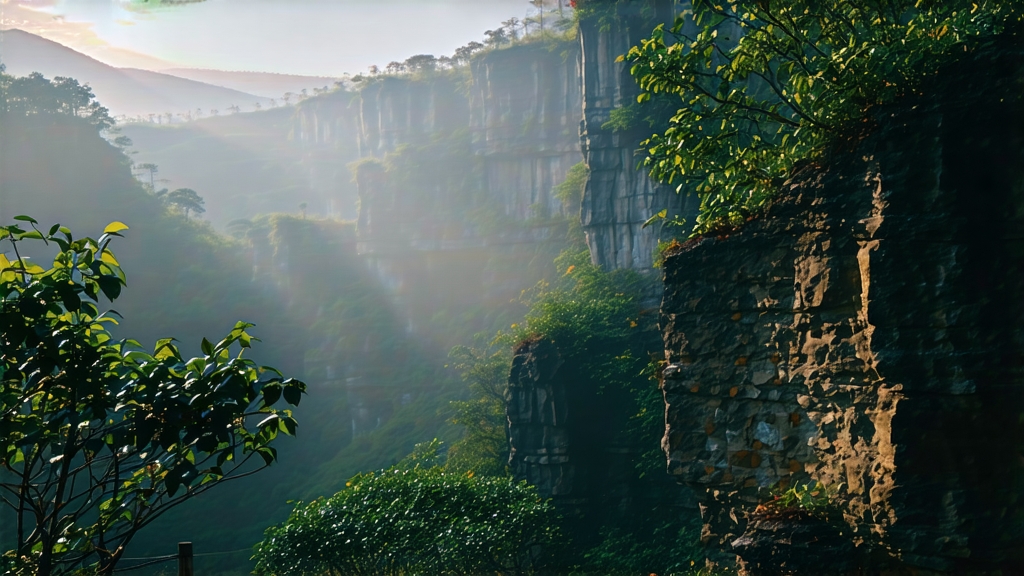
When Chinese tea lovers speak of “rock rhyme,” they are invoking the stony soul of Da Hong Pao, the most celebrated oolong from northern Fujian’s Wuyi Mountains. Literally “Big Red Robe,” this tea carries a legend of an imperial scholar whose mother was cured by its liquor; in gratitude he draped his crimson court robe over the scraggly bushes that had produced the cure. Whether myth or marketing, the story hints at the reverence Da Hong Pao commands and the visual drama of its dark, twisted leaves unfurling like imperial silk in hot water.
Geology first, then genealogy. The Wuyi range is a 650-million-year-old slab of volcanic tuff and granite, eroded into a labyrinth of narrow gorges whose cliffs reflect heat onto narrow terraces only a few meters wide. Here, mineral-rich runoff drips constantly onto the roots of tea bushes that struggle for nutrients, producing tiny, stress-concentrated leaves. The local microclimate—80 % humidity, frequent fog, and temperature swings of 15 °C between day and night—slows growth so that a single budset needs forty-five days to mature, twice the time of valley bushes. The result is a leaf architecture dense in aromatic precursors and polyphenols, the chemical foundation of rock rhyme, the yan yun that connoisseurs describe as a cooling, tingling minerality that arrives minutes after swallowing.
Da Hong Pao is not a single cultivar but a stylistic family. The original six “mother trees,” still visible on Heavenly Heart Cliff, are now protected and no longer harvested; the last 20 g of their tea auctioned for ¥9.6 million in 2005. Today’s market offers three tiers: qizhong (purebred), made entirely from cuttings of the mothers; shuixian (narcissus) or rougui (cassia) blended to mimic yan yun; and commodity dahongpao, a skillful marriage of Wuyi leaf with neighboring regions to meet global demand. Purists seek the first, but master blenders argue that a well-constructed third-tier can still deliver the limestone echo that defines the genre.
Plucking begins at Qingming when the leaf is 70 % the size of a thumbnail. Two leaves and a bud are snapped, not cut, to keep the stem hollow intact—this tiny straw later helps the leaf dehydrate evenly. The first transformation is sun-withering: trays of leaf are laid on bamboo mats for twenty minutes of late-morning sun, enough to soften cell walls without bruising the edges. Indoor withering on water-heated racks follows, where the leaf loses 10 % moisture every hour while enzymes convert lipids into floral lactones. The critical “green-making” starts at 2 a.m., when the air is coolest and most humid. In a ritual unchanged since the Ming, artisans pile 5 kg of leaf onto a rattan tray and shake it with a snapping motion that bruises peripheral cells while keeping the midrib alive. After eight cycles—each followed by a thirty-minute rest—the leaf edges oxidize to a copper red, whereas the center stays jade green, the visual hallmark of semi-oxidized oolong.
Oxidation is arrested at 30 % by a 280 °C tumble in a cast-iron wok, hotter and shorter than the pan-firing used for green tea. The goal is to lock in the floral top notes while caramelizing the sugars that will later develop into cocoa and nutmeg. Next comes the Wuyi signature: charcoal roasting. Using only the embers of local hardwoods—mostly longan and peach—the tea is baked in bamboo baskets lowered into ash-lined ovens. A master roaster judges temperature by the color of the ash (white = 90 °C, faint cherry = 120 °C) and the interval between “pops” from escaping steam. Over six weeks the leaf is baked, rested, re-baked, and rested again; each cycle deepens the cup while driving out the last vestiges of grassy acidity. The final moisture target is 3 %, low enough that a strand of leaf snapped in half should sound like a pine twig.
To brew Da Hong Pao well, treat it like a shy hermit: coax, don’t bully. A 120 ml gaiwan or small Yixing pot is pre-heated with 95 °C water; 6 g of leaf—about two heaping tablespoons—goes in and is immediately showered to “wake the robe.” This first five-second rinse